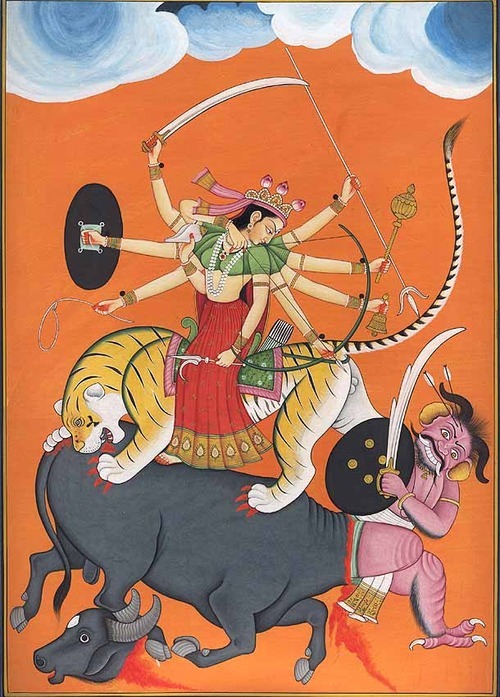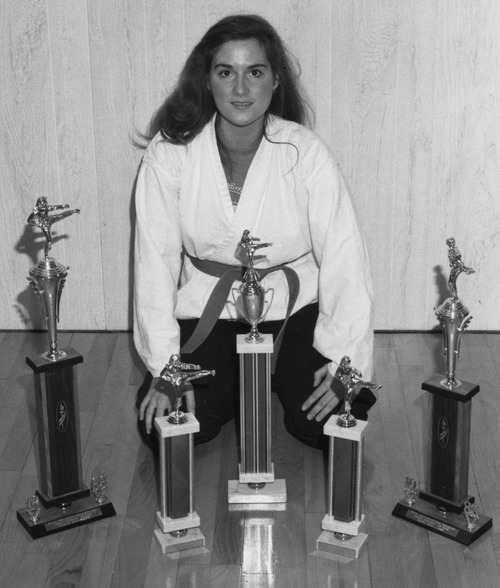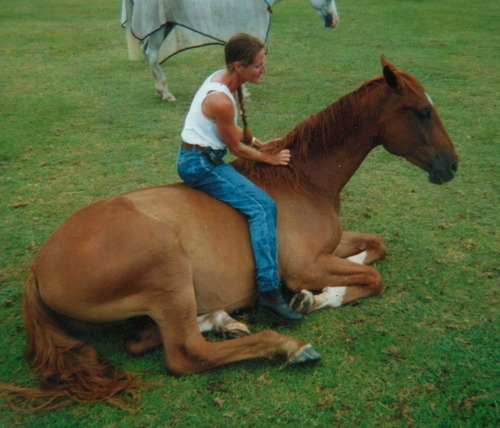
A Woman in the Martial Arts
By Annette Singer
(From the Wind School Archives)
Note from Shifu Christopher Goedecke: I first met Miss Singer at the College of Saint Elizabeth, NJ, in the early 1980’s when she enrolled in my college self-defense course. She was a tall, vivacious red head with a fiery confidence. She trained hard at a time when women were just establishing themselves in the American martial art scene. An articulate, sensitive and intelligent woman, Annette jumped on my offer to share her feelings about being a female martial artist. Though readers might pick up hints of a past era, what Miss Singer wrote over thirty years ago still rings some truth for women’s journey in the martial arts today.

I SHOULD HAVE REALIZED that first day, when I erringly crossed my gi top right over left, that I had entered a man’s world. After all, men button their shirts on the left side, and evidently close their gis in the same manner. I hastily fixed my top and, before I knew it, found myself standing at the end of a long white belt line – one of the handful of women in a room steaming with the musky odor from the swarm of male bodies that dominated it. The impact was staggering for, having sought out Karate in hopes of discovering a new strength, I instead found myself completely overwhelmed by a world in which I felt the female had no place. The masters, as well as the students, were almost exclusively male, and the values, priorities, and goals they espoused seemed completely masculine in orientation. It was not long before I realized that as a woman, I was coming into the dojo with a completely different framework of reference.
Although I spent my early childhood wrestling with three brothers, playing “Cowboys and Indians,” then later advancing to “Cops and Robbers,” I was accustomed to assuming the submissive role. Any girl who wanted to romp with the boys was doomed to play an Indian, a robber, or whoever the conquered party of the day was designated to be. Fate for the tomboy such as me usually involved being trussed to a fence in the backyard, sentenced to burning at the stake, and abandoned there until mother noticed my absence at the dinner table. As I grew older, the high incidence of sexual crimes against women only served to reinforce the ingrained concept of a female as powerless to protect herself against the advances of a male. Perhaps it was a desire to be able to protect my own autonomy, a fear of victimization or of having my personal space infringed upon that attracted me to Karate in the first place. Paradoxically though, one day of workout rendered me even more intimidated by male prowess than had previously been the case.
Initially, I consoled myself by saying that it was my own lack of comparative strength that rendered me feeling so totally inept. After all, white belt men could execute ten knuckle pushups for every one of my feeble attempts. When they punched, their gis flipped crisply, while my limp, rolled-up sleeves sagged lifelessly. It was only a matter of time, however, before I realized that the major setback was not my physical limitations, but my own deep-rooted inhibitions.
It has been stated that half of knowing what you truly desire is acknowledging what you must sacrifice before you can obtain it. I had only been studying Karate a few days when I ascertained that in order to become accomplished at the art I would have to modify some of my own ideas of what being “feminine” involved, and redefine “womanhood” for myself. The first battle was learning to kiai.
One learns at an early age that yelling is unladylike, that nice girls don’t sweat, and that punching is only for men. Nevertheless, daintiness gets one nowhere in the dojo, so by the end of one week I was suddenly enticed by the prospect of spontaneously giving everything I had. I reached back for the part of me that as a child had screamed war cries, clamored up trees, and kicked the bully who squished my pet caterpillar, and found, to my surprise and delight, that the wild little heathen was still there. Over time, the search also unearthed a level of intensity and an ability to discipline this energy that I never had dreamed existed within me. Having been given a taste of this passion fruit, I found it not unlike an aphrodisiac that sparked an all-consuming love affair between me and Karate. Now when the air was pierced by a myriad of voices kiaing, mine was unmistakably among them. When workout concluded and my belt was saturated with perspiration, my hair plastered to my scalp, I no longer feared that these conditions posed a threat to my mystique as a “femme fatale." Rather, I noticed an interesting phenomenon. Within a short while I found myself with some of the closest male friends I had had since my tomboy days. Oddly, enough, with society’s mores about physical contact set aside, there was nothing barring the way of a good solid male/female friendship. This is not to suggest that once my own attitudes about myself changed, the whole world changed with me. I still faced struggle after struggle with misconceptions and stereotypes, not only outside the dojo, but inside as well.

Annette Singer 1983 Wind School Student
It was a wintery Saturday afternoon. Home for the holidays, I was practicing kata in our musty basement. Kiaying, by now, was a natural form of expression for me, and actually, this particular day, the dust in the air prohibited any blood-curdling howls. Therefore, I was not ready for the impact this would have upon my father. The cellar was cold, so I finished a brief workout and, arriving at the top of the staircase, was just in time to hear a hushed voice demand of my mother "What has happened to my little girl?" He might as well have cried, "They have created a monster!" A female friend of mine faced a similar reaction from her boyfriend. While he had previously enjoyed roughhousing with her, he refused to once she began to study Karate. I have personally observed that many men relish the idea of being able to overcome a woman physically, and that any threat to this ability is strongly resented. Nor is this type of attitude only found outside the enlightened walls of the Karate school.
One of my earliest encounters with "dojo discrimination” was when I was a yellow belt. I had been instructed to spar as a learning experience with a tall, husky black belt who greatly resembled a muscular teddy bear. Expecting a real challenge, if not instant death, I really attacked with vigor, only to find that he would barely even block my techniques. I was no powerhouse, but I distinctly remember that at least one roundhouse kick to the solar plexus evoked a gasp of shock from my reticent opponent. He never once retaliated, however, and when he later complimented me on my ability, I demanded in frustration why he refused to fight back. Sheepishly, he informed me that he had always had a great fear of hitting a woman. Even more aggravating than this attitude is that of the “pseudo-gentleman” who refuses to spar with a female at all. How can a woman hope to learn to defend herself against a larger, more powerful opponent if even her fellow students refuse to help her? Nevertheless, I have discovered over time that if a woman is aggressive enough when sparring with the reluctant male, he will eventually feel threatened and retaliate, if for no other reason than because he feels that he is expected to be superior in the match. It is ironic that the very social conditioning that causes a man to avoid striking a woman also goads him to fight his hardest once he has decided to engage himself in kumite with her.
My present instructor is incredibly well-attuned to the difficulties a woman encounters in such a male-oriented environment, and, perhaps his philosophy of teaching is the most conducive to growth. He treats every student as a separate entity and, thus, in his class there are not twenty-five men and three women, but rather, twenty-eight individuals, each with their own personal strengths and weaknesses to discover and contend with. This attitude generates an atmosphere in which students exhibit a mutual respect that is not dependent upon belt level, age, or gender, but instead reflects an intrinsic appreciation of the uniqueness of every human being.
I do not in any way mean to imply that men and women are identical physically, emotionally, or spiritually. Differences in upper body strength, hip structure, and hand size account for just a few of the physical advantages and setbacks a woman faces when she studies Karate. In addition, I believe that women approach life in a manner that is highly intuitive and sometimes even mystical. Because she is so sensitive to the fine arts and beauty, Karate can take on an added dimension for her. In contrast to having to seek the aesthetic outside herself, a woman can suddenly create the fluidity, unity, depth, and spontaneity so characteristic of art through the intricate movements of kata. The beauty then becomes an extension of one’s own body, culminating in an exhilarating experience unequaled by any other.
When viewing the rising trend of women studying the martial arts, it is necessary to recall that all human beings are two fold entities—both physical and spiritual in nature. Karate is an art form that guides the two to work in harmony, a goal to be sought by men and women alike. The true battle is that within oneself—an arduous and frequently painful task. Karate can be a means of attaining that end, and while a woman must resign herself to the fact that her belt will inevitably insist on slipping back up to her waist, the greatest endowments of the martial arts—enlightenment and self-knowledge will not be denied her if she truly strives to achieve them.

In Annette’s own words today; “I have had a life full of martial arts—many different styles and disciplines—2 black belts and some amazing experiences. But to be honest life has been mostly dominated by husband and horses for the last 20 years, with a brief stint on the professional women’s tennis tour.”

Annette Singer with Thor in Australia 2012
